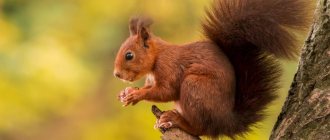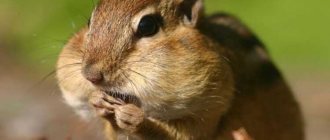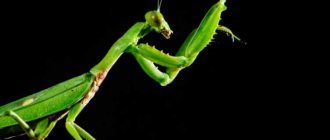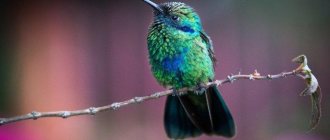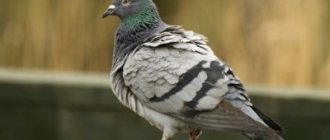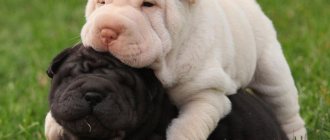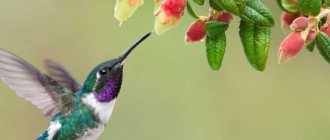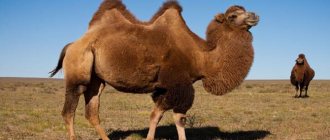Review author: “ZooVita”
A domestic horse is an animal belonging to the wild horse species, order of odd-toed ungulates. This species also includes subspecies: wild Przewalski's horse and tarpan.
The last tarpans disappeared in the 19th century. Przewalski's horse was miraculously preserved; Thanks to work to restore their numbers, they can be seen in the wild. Domestic horses appeared presumably 5-6 thousand years ago; they are believed to be descendants of the Tarpans.
Description of the animal horse
In the photo of domestic horses you can see that the animals have an elongated head with large eyes and wide nostrils, a long curved neck, and a mane of protective hair on the crest of the neck.
The eyes are usually brown or blue, the largest of any mammal. The location of the eyes allows animals to see 350 degrees. Horses do not see what is behind and in front of their nose. Hearing is much better developed than vision.
Stallions, as a rule, have 40 teeth; mares have 36 teeth; they do not have fangs. But it happens the other way around. Teeth wear down over the course of life, but continue to grow. Thanks to this, the length and shape of the teeth can be used to determine the age of the horse.
The horse's body is rounded, the chest is usually wide and deep; the back is elongated, with good muscles; long mane and tail. The belly is round; Sports horses that are fed less voluminous feed have a tucked belly. Long, slender legs.
Like other representatives of the equid order, horses have an odd number of toes. The middle finger, the only one developed, is covered by the hoof.
Horses have a good memory; they quickly remember what they have learned and easily find their way home.
Interesting Facts
- Horses are hardy, fast in movement, and have a high ability for useful productivity, due to which they are recognized as versatile working animals, used in agriculture and industry, as well as in military affairs and sports. When choosing a live workforce, preference is always given to horses.
- Horses are also valuable productive animals. Productive horse breeding, for example, in Russia is about 7% and is a source of valuable dietary meat. In Western culture, horse meat is used only as food for domestic animals (dogs), and only certain peoples use this meat and milk for food. Kumis, which is prepared from mares’ milk, is considered a healing drink (it is credited with tonic and medicinal effects, healing diseases of the lungs and stomach). Even in recent years it has been used when feeding infants. Not every mare produces milk with the necessary composition to obtain excellent quality kumiss. In Russia, subspecies such as Yakut, Bashkir and Mongolian horses are bred for this purpose. The production of horse meat (horse meat) is more common in countries such as Mongolia, the states of Transcaucasia and Central Asia, Russia (Yakutia, Tuva). Horse meat is also added to many types of smoked sausage. Italy, France, Belgium, Japan and Yakutia have recognized horse meat as an important product, which is due to its special chemical composition. Horse meat is used in medicine during the recovery period after jaundice, and horse fat is used to treat frostbite and colds. But, for example, in the territory of Turkmenistan it is prohibited to eat horse meat.
- Domestic horses are also a valuable raw material for the pharmaceutical industry, for example in the production of anti-diphtheria serum.
Domestic horse breeds
Currently, at least 200 breeds of these noble animals are bred in the world. Breeds of domestic horses are divided into: riding, draft and heavy draft breeds.
Horse
- Akhal-Teke,
- Ukrainian riding,
- Tersk breed, and others.
Sled
- Orlovskaya,
- Belarusian harness, and others.
Heavy-duty
- Brabançon,
- Percheron, and others.
The first ancestors. Where did you live?
Where does the horse live? What does it eat? Archaeologists and paleontologists claim, judging by the fossils found, that the first ancestors of the modern horse appeared in North America. However, they quickly spread throughout the planet due to the rapidly growing population.
Along the natural earth corridors that previously connected America and Eurasia, these animals penetrated to other continents. The horse was originally the size of a dog and had toes instead of hooves. However, the evolutionary process has greatly transformed it over fifty million years. The need to conquer new territories, the danger posed by predators, the distances that needed to be overcome more and more. All this provoked the growth and development of this species.
Horse colors
Suit is the color of the hair. There are single-color and multi-color horses. Some have marks and scorch marks; As animals age, gray hair may appear.
The main horse colors are black, red, gray and bay. All others are derived from the main suits.
Stable
Over time, the need arose to build a house where horses live. Indeed, in connection with the beginning of a sedentary lifestyle, a person began to live in certain strong buildings in which he could hide from the cold and predators, sleep and eat, and also store all his property.
But the problem arose of where to place the domesticated animals. After all, by their nature they could not get along with a person under the same roof. Including the horse. It required a separate room, which soon acquired the name of a stable. What it is? A stable is a place where a domestic horse lives. These rooms are usually larger than human ones in area and ceiling height. After all, horses are much larger than humans.
Keeping horses at home (rules)
Keeping horses at home requires compliance with certain rules. To keep animals healthy, they need: cleanliness, fresh air, absence of drafts, constant movement and good quality food.
Herd keeping of horses
This type of housing is the most natural and beneficial for horses, close to natural conditions. For grazing, areas that are free of poisonous plants are enclosed with a fence or mesh. It is advisable to have shelters where animals can shelter from bad weather. The pasture must have clean water for drinking.
Horse stables
When kept in a stable, horses are allocated separate stalls with a feeding trough. The stable should have a non-slippery floor and good bedding made of sawdust or straw. The stalls need to be cleaned and cleaned regularly. Every day horses must walk outside. For this purpose, levadas are installed - fenced areas cleared of garbage.
Practical use
Horses have been used by humans for various purposes. For example, the oldest breed of Icelandic horses has long worked in the fields, although these animals are small in size. The history of relations between beautiful powerful animals and people goes back more than one thousand years. During this time, horses acquired many professions:
- It is easier for a policeman to perform his duty in places where a car cannot pass. For example, in residential areas of the city and park areas. In the saddle it is much easier to catch up with a criminal and overcome obstacles. Mounted policemen first appeared in London at the beginning of the 19th century. Today they are in Canada, the USA, Spain and Russia.
- Artist - many scenes in feature films would be incomplete without the participation of horses. Animals are specially trained to perform various tricks before filming. Even the circus arena was created specifically for working with horses - the fact is that it is in a circle with a diameter of 13 m that it is more convenient for them to run at full speed.
- Doctors - horseback riding gives people positive emotions, which has a beneficial effect on their health. Hippocrates advised his patients to stay in the stable longer. Those who work in contact with horses are half as likely to have heart disease and diabetes. In many European clinics, horse riding is included in the rehabilitation course for children with cerebral palsy - patients communicate with “doctors” for several hours a week.
But these are all relatively new activities. In ancient times, life forced people to use horses as labor. Thanks to their endurance and speed, they helped in agriculture and military affairs. To this day, horses are necessary for transporting small-sized cargo , while cultivating vegetable gardens, for transporting hay and removing snow, for moving along mountain paths and for grazing livestock. Foresters and doctors cannot do without a workhorse in the remote taiga and in the mountains.
Nutrition for horses (review)
Horses are herbivores, adapted to eating large amounts of plant food. The most natural and healthy food for them is pasture grass.
In winter, hay, straw, as well as oats, barley, and corn are used for feeding.
In addition, wheat bran and cakes are added to the diet; carrots and apples are very useful. Vegetable oil and table salt are added in small quantities.
Horses should not be fed low-quality feed, fresh bread, or foods that can lead to fermentation. Feed should be in small portions, 3-5 times a day; Avoid eating low-quality feed.
Horse in a private yard
Do you have your own yard and have you decided that your horse will live next to you? Since we have exactly this experience in keeping our horses, we will be happy to share it. So, the horse is in his personal yard. How to organize her accommodation correctly?
Please immediately note that in financial terms this is no more profitable than keeping a horse billeted somewhere that is not very cheap. In order to somehow, at least partially, cover the costs of maintaining your horse, it’s a good idea to take another horse to stay. Again, your horse will have more fun with company (don't forget that a horse is a herd animal).
If you have already decided to do this, take a close look at your site!
Preparatory work
It is advisable that:
1) the place was not swampy (otherwise it would be necessary to carry out reclamation) 2) the neighboring areas did not directly border the territory where your horses will be (or you can put a high, blind fence) 3) there was enough space for:
- stalls - ammunition storage - fodder - hayloft - clean sawdust storage - “dung house” - horse walking - household storage. inventory - there was good access at any time of the year for large vehicles.
Another:
Before you decide to equip your yard, pay attention to the surrounding area. Will you have somewhere to walk, ride a horse and graze your horse (or maybe more than one), without disturbing your neighbors or stressing the horses??
Infrastructure
Is everything in order and the yard is planned? Then, let's move on to the next stage. And no, this is not construction, you need to figure out some more important details.
1) Water! It should be available all year round, clean, affordable and in unlimited quantities.
2) Electricity! Also, it should be served without interruption.
3) Hay! It is necessary to find out in advance contacts with suppliers, the quality of their hay, and how honest and obliging potential suppliers are (it is better to have a whole list of such suppliers - just in case).
4) Sawdust! (The same scheme as with hay suppliers).
5) Concentrates! (see two previous points).
6) Manure and waste sawdust! Decide right now where you will put it all! I was lucky - there are a lot of gardeners around, but there are no stables in our village, so there is no competition. We pack the manure into bags, put the bags in a special shed, which has good access, and sell it inexpensively to gardeners. Neighbors pick up sawdust for free, also in bags, and return the bags.
7) Find out where the nearby veterinary station is and whether you can register your horses there. Also, stock up on the phone numbers of veterinary pharmacies and practicing veterinarians.
Construction
I am in favor of a timber stable without an indoor passage, because... I think the passage is absolutely unnecessary, plus in winter the horses will have to heat the passage with themselves, in addition to the stalls. Ammunition should be stored in the ammunition bin, and food should be stored in the stern, and not in the aisle. In addition, the doors are made with double doors (at the top and bottom of the door), which allows the horses to breathe fresh air and see what is happening on the street. The top flap of my horses is open in calm weather down to -15 degrees. I do not recommend making a hayloft in the attic, because, from experience, it is not convenient.
Construction of stalls
The stall for an average horse in our latitudes (taking into account winter) is optimally 3m x 3m with a ceiling height of 2.5m to 3m, depending on the height of the horse. The partition between the horses should be made strong, and so that they can see each other, communicate, but cannot injure each other. The walls must be well insulated and have enough heat capacity so that there are no drafts and heat is retained. I prefer a wooden floor, made of boards no thinner than 50mm (we have 150x100 timber laid), after installation, it should be soaked in used machine oil or an industrial water-repellent antiseptic and allowed to stand for several days until completely absorbed.
The windows (the more there are, the brighter and more interesting they are) have double-glazed windows, they open very conveniently. Separated from direct contact with the horse by a grid of reinforcement, located at a height of 170 cm. The top door leaf starts at the same height. The ceiling is insulated with a thick layer of sawdust. The lamp is located exactly in the center of the ceiling in each stall.
Since horses spend 14 hours a day outside, I consider heating the stable a harmful idea, since there should not be a very strong temperature contrast. If it is below -15 degrees outside, the horses walk in winter blankets, and the temperature in the stable is not below -5 degrees. If it’s colder in the stable, I leave them in their stalls in fleece blankets overnight.
In winter, the layer of clean dry sawdust is from 15 cm; in cold weather, more hay should be given - up to 20 kg per day.
Ammunichnik
The size of the harness depends on the number of horses. You should take into account that, in addition to saddles, headbands and saddle pads, blankets take up quite a lot of space, plus you also need to think about the place where to dry them. Some horse owners dry blankets directly on their horses. Probably because there is no place to dry it.
The tank should be well ventilated to avoid humidity and heated in winter. Special brackets are provided for saddles. You can make them yourself from a metal corner, or from round wooden poles, or... in general, there are many options. In the end, you can hang a stick on a string and hang saddles on it.
Consider where and how the brushes and first aid kit will be stored, and where you will wash the bits, boots, and brushes. If possible, it would be nice to install a sink.
Our locker room is combined with an ammo box, but if possible, it is better to make a separate one.
If you want your horses to always look neat, make sure that their equipment is clean and well-groomed. It is necessary to organize the process of washing saddle pads and blankets. Wash saddle pads at least twice a week in the summer.
Stern
We use a standard metal prefabricated garage for the stern. Very comfortably. The roof does not leak, and precipitation does not enter from outside. The garage has entrance doors, through which we receive food, they go out onto the driveway; We also cut out a passage at the end in order to get there from the yard, and so that there would be a draft that would make the room dry. The floor is concrete (on the foundation).
We do not recommend storing concentrates in bags - get barrels (preferably plastic), always with lids. In the fall, we buy oats in large quantities, preferably enough to last until the new harvest, because... firstly, closer to summer it becomes expensive, and secondly, it loses quality. Wheat bran has a very short shelf life, so you need to take it in such quantities that it does not have time to spoil. Compound feeds also have a certain shelf life, be sure to find out which one, because... The horse's digestive system is very delicate.
Cake, grass meal, etc. It makes no sense to buy in large quantities: they are always in stock, and their cost varies depending on the season.
Be carefull! Sooner or later, rats will visit your feed! First, a couple of scouts will appear and, if you do not take action, they will multiply. Keep the feed area clean; if you spill oats or anything else edible, clean it up immediately. If they still found “guests”, run to the household goods store for poison. Buy non-grain poison, place it in places inaccessible to other animals. Read the name of the antidote on the package and, just in case, purchase it. There is no need for the stern to border directly on the stable.
Closer to autumn, large quantities of voles will be brought to you along with the hay. And then be ready! Get yourself a very good mousecatcher cat in advance.
Sawdust storage area
Sawdust is supplied in two ways:
- in bulk - in bags
If you find a base where sawdust is packed into bags, you are in luck - for a small private farmstead this is an ideal option, because... bags of sawdust can be stored under any canopy. We have allocated a place for them in the feed room; if there is a hayloft, it is not difficult to allocate a corner next to the hay.
If a dump truck unloads sawdust for you, it’s also not a problem. Determine a place where a truck with a large volume of body can easily drive up and easily lift it to dump sawdust. Buy waterproof material of such a size that you can cover the entire sawdust pile from precipitation and wind, drive pegs around the perimeter to secure your “cover” and it will not be blown away by the wind. There is one big disadvantage in this method of storing sawdust: in winter, after heavy snowfalls, it is difficult to dig out the sawdust pile.
Keep in mind that from mid-December to mid-March there may be serious interruptions in the supply of sawdust, because... During this period, as a rule, woodworking production is frozen due to lack of orders. We advise you to calculate the consumption of sawdust by your stable and, based on the calculation, stock up on them for future use.
As for straw, in terms of using it as bedding, I can’t say anything, because I couldn’t find high-quality straw for these purposes in our area.
Dung house
I don’t like the dung heap as such - it’s not aesthetically pleasing and smelly, plus there are flies. Therefore, we did everything to avoid creating this same pile.
We have a “dung house” - a small, iron-clad shed adjacent to the garage from the outside. It is not visible and is convenient for cars to access. We put the manure in bags, tie them up and sell them inexpensively. Therefore, we have a queue for manure; in the off-season, the bags are stored, up to 60 bags can be stored.
What to do with used sawdust
The spent sawdust, also in bags, is placed outside the gate, where neighbors pick it up. Empty bags are returned to us.
What would we do if our neighbors didn’t collect waste sawdust?
There are three options:
1) We would buy a container for garbage, store sawdust there and contact a paid service for removing containers.
2) They would store them in the same bags and, when there are enough of them, they would contact the service “we will take everything away.”
3) If financial capabilities allow, you can buy a boiler that is designed for the combustion temperature of sawdust (and it is high, ordinary boilers are not suitable) and is capable of burning them wet and heating rooms with waste sawdust.
Levada
Actually, a levada is a fenced pasture. Since in a small area it is unlikely that any vegetation will coexist with horses, the fence for walking is a corral.
The larger area you can allocate for a pen, the better. Firstly, you will provide your horses with space for active and varied movement, and secondly, if there are several of them, the degree of injury depends on the number of square meters. Horses periodically sort things out; they injure each other much less often and less if they have enough free space to escape. We have about 7-8 acres for four horses to pasture. A larger number of heads in such an area is a strong overkill, so our limit is 4 heads, torsos, tails and 16 legs! In the future, I really hope to move to a place where my pets will be able to walk in the endless levadas during the grazing season...
Preparing the territory
We highly recommend wrapping tree trunks in the enclosure with a metal mesh with small cells.
We collect manure in the paddock as many times as we feed the horses. We feed them, regardless of the time of year, outside, if the weather permits.
It is desirable that the site has an irregular shape, with “nooks and crannies” and “pockets”. Horses love to rest in such a corner after eating. If possible, you can make it calm, then the precipitation will not be terrible and neither will the wind.
In the summer, when there is no rain, we water the site copiously. Firstly, so as not to create dust. Secondly, so that the hooves do not dry out. Thirdly, so that the smell of urine is not active.
In winter, the paddock is illuminated by a floodlight.
Needless to say, there should be no potentially dangerous items or objects in the area where horses roam.
One of the biggest advantages of home stables is the ability to provide your horses with maximum exercise time. Therefore, we recommend that you arrange your paddock responsibly so that your horses feel comfortable and you and your neighbors feel at ease.
PS Two years have passed since I wrote this text. We managed to move to a place where our horses have the opportunity to walk in the levada. Which they and we are very happy about!
Author: Anastasia Volkova. “The manual was written by me 4 years ago, but was never published. Thanks to EquineManagement.ru, I have the opportunity to share my experience of keeping horses, outlined in the brochure “I Want a Horse,” with those potential and current horse owners who might be interested.”
Rules for watering an animal horse
It is desirable that animals have constant access to water. This can be achieved by equipping automatic drinkers. A horse drinks 20-40 liters of water per day. Water for drinking must be clean.
You cannot give water to a hot horse, as this can lead to a dangerous illness. In the absence of automatic drinkers, animals are watered before feeding.
How did domestication occur?
According to the theory, the first culture to domesticate the horse was the Botai, which lived between the 37th and 31st centuries BC in central Eurasia. To confirm or refute this information, scientists conducted a genetic study. It turned out that Botai horses are in no way related to domestic horses, but are related to wild representatives of the Przewalski breed.
Another hypothesis says that the first people to domesticate the horse were the ancient inhabitants of modern Bashkortostan. Within the republic, scientists have found animal remains dating back to the 7th–6th centuries BC. e.
Horse animal breeding
A female horse is called a mare, a male horse is called a stallion, and a baby horse is called a foal. A castrated stallion becomes a gelding.
Horses are capable of reproduction by the age of one and a half years. But the optimal age for mating is 3-4 years.
The duration of pregnancy (pregnancy) is 310-370 days and depends on many factors: quality of feeding, breed, age and physical condition. Most often, a mare gives birth to one foal.
With a successful pregnancy, the foal is born quickly and can stand on its feet within 30 minutes. The mare feeds the foal for 4-6 months.
Oryol trotters
Oryol trotters are distinguished by an ideal graceful gait, well-developed limbs and a long, elongated back. The height of the Orlovets is 175 cm.
The most common colors are grey, bay and black, and occasionally piebald. The fur of trotters is soft and thick, plush to the touch.
The breed standard is taken into account with a broad-browed head with an Arabian profile, expressive eyes and small, neat ears.
The neck of these beautifully built, somewhat temperamental, good-natured and friendly horses is crowned with a lush, amazingly beautiful mane, which you just want to touch with your hand.
There are no more horses similar to these types of horses - they are unique. Those who love to ride horses would consider it a pleasure to ride an Orlovets, and athletes most often choose representatives of this particular breed.
Caring for horses at home
Horses are cleaned with a fluffy brush and sometimes washed. The eyes and nostrils are periodically washed using a sponge soaked in clean water. The mane and tail are combed and debris removed.
The horse's legs require special care. After work, it is advisable to massage them with a straw tourniquet. Hooves should be checked daily and, if necessary, freed from dirt and soil.
The hoof horn of horses constantly grows. Under natural conditions, the hoof horn wears off due to the fact that a wild horse moves a lot; a domestic horse needs to have its hooves trimmed.
Behavior
Domestic horses are grazed in the steppe throughout the year, and hay is occasionally used to feed them. In severe winters, snowstorms and ice, when it is difficult to get food from under the snow, they especially need additional food. In such conditions, animals lose a lot of weight and often die. In the summer they gain weight and return to normal.
Domestic species behavior
Domestic horses are very peaceful creatures, but can take care of themselves. In clashes with predators, they use their hooves and teeth. Herd stallions bravely fight their opponents. They are fierce and bold, rushing at predators, making a “square” stance, knocking foals into the center of a circle of adults, and tightly surrounding them with their hind legs outward. But usually horses still prefer to simply get away from danger. Their natural ability to run quickly helps them with this. By the way, horses often save riders by running away. Horses can be easily trained to work together with a tiger, bear, or lion. This intelligent animal is easily accustomed to understanding and following commands such as “Accept!”, “Walk!”, “Trot!”, “Gallop!”, “Stop!”
Using horses in work
Depending on the breed, physical form, and character, horses are used in different fields: sports, horse riding, horse racing, therapeutic riding (hippotherapy), and household work. These graceful animals can be found in mounted police and circus shows. Breeding animals are used for breeding at stud farms.
Common classification
Today there are hundreds of horse breeds in the world; according to some sources, in 1993 there were 427 of them. About 60 were bred in the former USSR; today only a few dozen of them have been preserved in Russia. The classification of breeds has not yet been fully developed; division is carried out according to different criteria:
- Zonal climate - steppe, forest, mountain.
- By purpose - riding, light harness, etc.
- By origin - cultural, transitional, aboriginal (local).
- According to breeding methods - factory, cultural herd and herd.
Small horses (ponies) and heavy draft horses intended for agricultural work have their own classification. Types of horses are also divided according to their intended purpose: for walking there are “hobby-class” horses, sports horses are used in horse riding and for hiking, trotters and racehorses are used for races at the hippodrome. Top 5 most beautiful horse breeds in the world:
- Frieze - developed in the Netherlands in the 17th century. by crossing native heavyweights and Spanish horses. Twice it was on the verge of extinction. Graceful creatures captivate with their beauty anyone who sees friezes.
- The Akhal-Teke is a riding breed bred in Turkmenistan about 5 thousand years ago, one of the oldest. She is purebred (had no crossbreeding). Tolerates hot climates well. Has a proud character.
- The Arabian purebred is another ancient breed, originating from the Arabian Peninsula. During a fast gait, the tail is held vertically. It is distinguished by a concave skull shape and large eyes.
- Orlov Trotter - bred in the Voronezh province under the leadership of Count A. Orlov at the beginning of the 19th century. Trotters are used in harnesses both as main horses and under saddle. Beautiful horses that can gracefully arch their necks have a good character.
- Donskaya - used in harness and for riding. Brought to the Don in the 18th and 19th centuries. He is in excellent health. Only red and brown colors are allowed, often of a golden hue with a darker mane. Well suited for learning to ride.
In modern Russia, the need for custom horses is three times greater than the available stock. After the collapse of the USSR, stud farms went bankrupt; it was difficult to care for thoroughbred animals in difficult economic conditions. Even in rural areas there are few working breeds left.
Horse lifespan
The average lifespan of a horse is 25-30 years. Animals used in sports usually live less - 18-20 years. Some live up to 40 years, very rarely, but there are centenarians who live up to 50 and even 60 years. Ponies can live 35-38 years.
In the wild, horses rarely live past 15 years. How long horses live at home is influenced by hereditary factors, living conditions, care and feeding. The most famous centenarian, Old Billy, lived to be 62 years old.
Where live?
It would probably be difficult to list all the places where horses live. It’s easier to name the places where they did not live. Indeed, in the process of their evolutionary development, horses settled almost throughout the entire planet and do not live except in permafrost conditions, in deserts and in very dense forests, such as, for example, tropical forest areas. And so, horses settled throughout the globe, in some cases changing their image and likeness. Examples include zebras, donkeys and kulans, which, although not similar to ordinary horses, are still distant relatives of them. They underwent changes as a result of evolution, when fate brought their ancestors into difficult and hostile conditions, where they had to adapt to the environment.
Photos of all types of domestic horses
Pinto
It is unlikely that Pinto horses can rightfully be called a separate breed, since this name only denotes their specific color.
But Americans are unlikely to agree with this statement, since they treat these cute spotted horses with great trepidation. Their name comes from the Spanish word "pitando", i.e. "colored".
Some scientists are confident that the Pinto's homeland is the Middle East, since these spotted individuals are preserved in drawings that date back to the second millennium BC.
When horses were brought to America, the indigenous people immediately fell in love with them because of their “camouflage” coloring.


